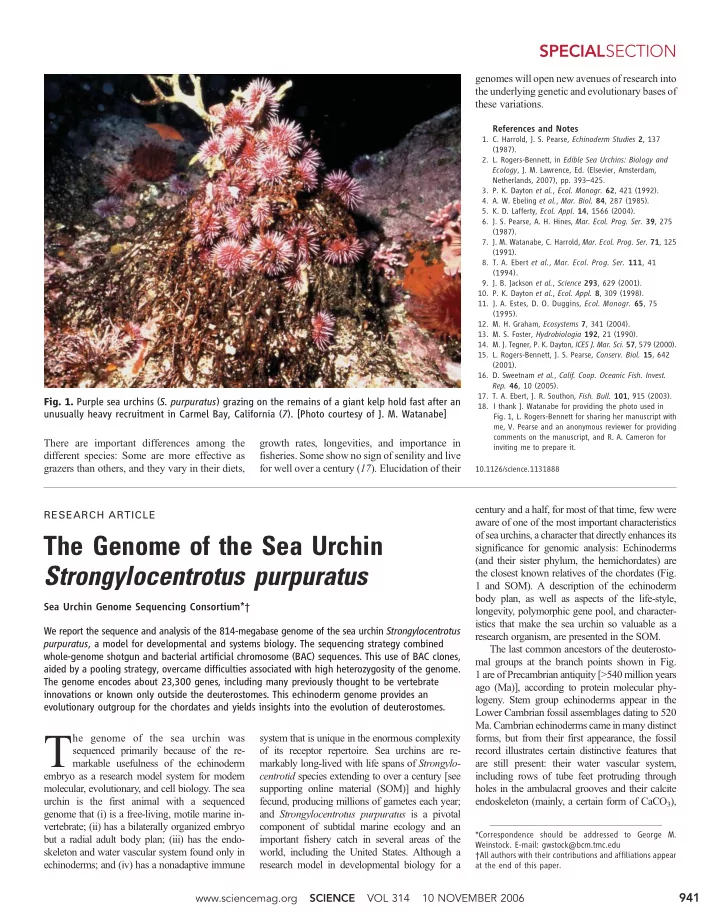

SPECIAL SECTION genomes will open new avenues of research into the underlying genetic and evolutionary bases of these variations. References and Notes 1. C. Harrold, J. S. Pearse, Echinoderm Studies 2 , 137 (1987). 2. L. Rogers-Bennett, in Edible Sea Urchins: Biology and Ecology , J. M. Lawrence, Ed. (Elsevier, Amsterdam, Netherlands, 2007), pp. 393 – 425. 3. P. K. Dayton et al. , Ecol. Monogr. 62 , 421 (1992). 4. A. W. Ebeling et al. , Mar. Biol. 84 , 287 (1985). 5. K. D. Lafferty, Ecol. Appl. 14 , 1566 (2004). 6. J. S. Pearse, A. H. Hines, Mar. Ecol. Prog. Ser. 39 , 275 (1987). 7. J. M. Watanabe, C. Harrold, Mar. Ecol. Prog. Ser. 71 , 125 (1991). 8. T. A. Ebert et al. , Mar. Ecol. Prog. Ser. 111 , 41 (1994). 9. J. B. Jackson et al. , Science 293 , 629 (2001). 10. P. K. Dayton et al. , Ecol. Appl. 8 , 309 (1998). 11. J. A. Estes, D. O. Duggins, Ecol. Monogr. 65 , 75 (1995). 12. M. H. Graham, Ecosystems 7 , 341 (2004). 13. M. S. Foster, Hydrobiologia 192 , 21 (1990). 14. M. J. Tegner, P. K. Dayton, ICES J. Mar. Sci. 57 , 579 (2000). 15. L. Rogers-Bennett, J. S. Pearse, Conserv. Biol. 15 , 642 (2001). 16. D. Sweetnam et al. , Calif. Coop. Oceanic Fish. Invest. Rep. 46 , 10 (2005). 17. T. A. Ebert, J. R. Southon, Fish. Bull. 101 , 915 (2003). Fig. 1. Purple sea urchins ( S. purpuratus ) grazing on the remains of a giant kelp hold fast after an 18. I thank J. Watanabe for providing the photo used in unusually heavy recruitment in Carmel Bay, California ( 7 ). [Photo courtesy of J. M. Watanabe] Fig. 1, L. Rogers-Bennett for sharing her manuscript with me, V. Pearse and an anonymous reviewer for providing comments on the manuscript, and R. A. Cameron for There are important differences among the growth rates, longevities, and importance in inviting me to prepare it. different species: Some are more effective as fisheries. Some show no sign of senility and live grazers than others, and they vary in their diets, for well over a century ( 17 ). Elucidation of their 10.1126/science.1131888 century and a half, for most of that time, few were RESEARCH ARTICLE aware of one of the most important characteristics of sea urchins, a character that directly enhances its The Genome of the Sea Urchin significance for genomic analysis: Echinoderms (and their sister phylum, the hemichordates) are Strongylocentrotus purpuratus the closest known relatives of the chordates (Fig. 1 and SOM). A description of the echinoderm body plan, as well as aspects of the life-style, Sea Urchin Genome Sequencing Consortium* † longevity, polymorphic gene pool, and character- istics that make the sea urchin so valuable as a We report the sequence and analysis of the 814-megabase genome of the sea urchin Strongylocentrotus research organism, are presented in the SOM. purpuratus , a model for developmental and systems biology. The sequencing strategy combined The last common ancestors of the deuterosto- whole-genome shotgun and bacterial artificial chromosome (BAC) sequences. This use of BAC clones, mal groups at the branch points shown in Fig. aided by a pooling strategy, overcame difficulties associated with high heterozygosity of the genome. 1 are of Precambrian antiquity [>540 million years The genome encodes about 23,300 genes, including many previously thought to be vertebrate ago (Ma)], according to protein molecular phy- innovations or known only outside the deuterostomes. This echinoderm genome provides an logeny. Stem group echinoderms appear in the evolutionary outgroup for the chordates and yields insights into the evolution of deuterostomes. Lower Cambrian fossil assemblages dating to 520 Ma. Cambrian echinoderms came in many distinct T he genome of the sea urchin was system that is unique in the enormous complexity forms, but from their first appearance, the fossil sequenced primarily because of the re- of its receptor repertoire. Sea urchins are re- record illustrates certain distinctive features that markable usefulness of the echinoderm markably long-lived with life spans of Strongylo- are still present: their water vascular system, embryo as a research model system for modern centrotid species extending to over a century [see including rows of tube feet protruding through molecular, evolutionary, and cell biology. The sea supporting online material (SOM)] and highly holes in the ambulacral grooves and their calcite urchin is the first animal with a sequenced fecund, producing millions of gametes each year; endoskeleton (mainly, a certain form of CaCO 3 ), genome that (i) is a free-living, motile marine in- and Strongylocentrotus purpuratus is a pivotal vertebrate; (ii) has a bilaterally organized embryo component of subtidal marine ecology and an *Correspondence should be addressed to George M. but a radial adult body plan; (iii) has the endo- important fishery catch in several areas of the Weinstock. E-mail: gwstock@bcm.tmc.edu skeleton and water vascular system found only in world, including the United States. Although a † All authors with their contributions and affiliations appear echinoderms; and (iv) has a nonadaptive immune research model in developmental biology for a at the end of this paper. 941 www.sciencemag.org SCIENCE VOL 314 10 NOVEMBER 2006
Recommend
More recommend